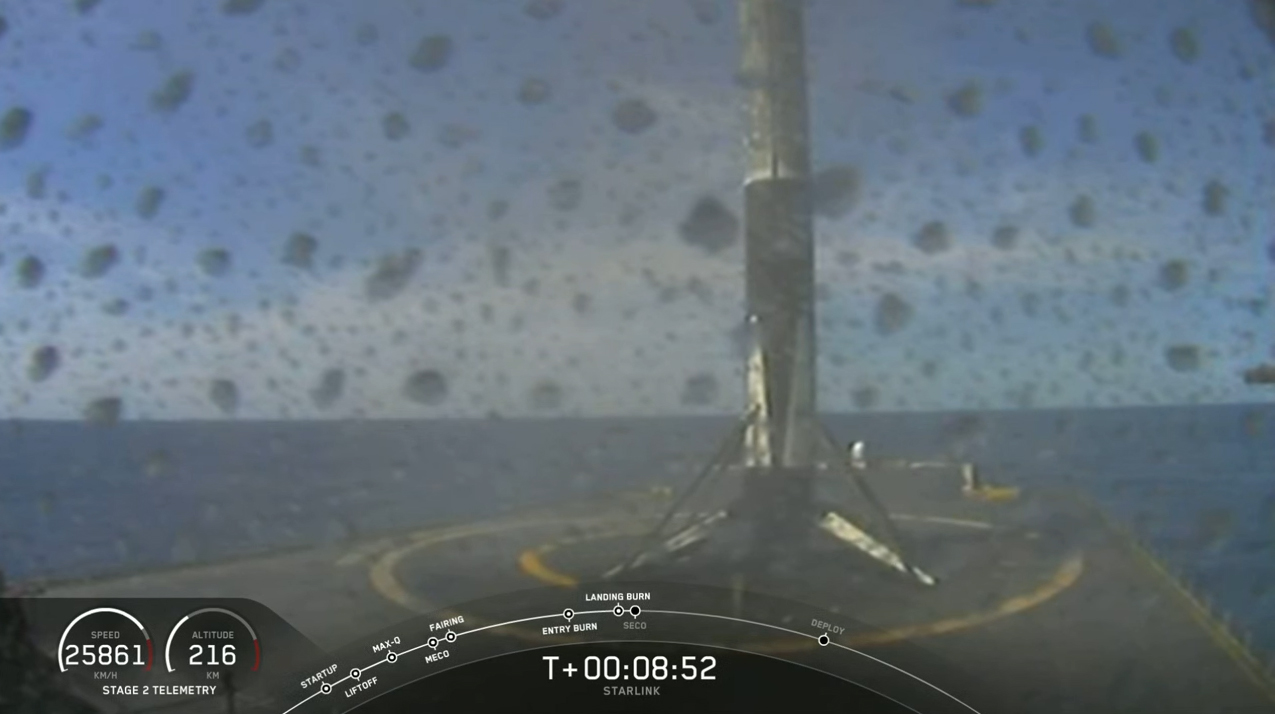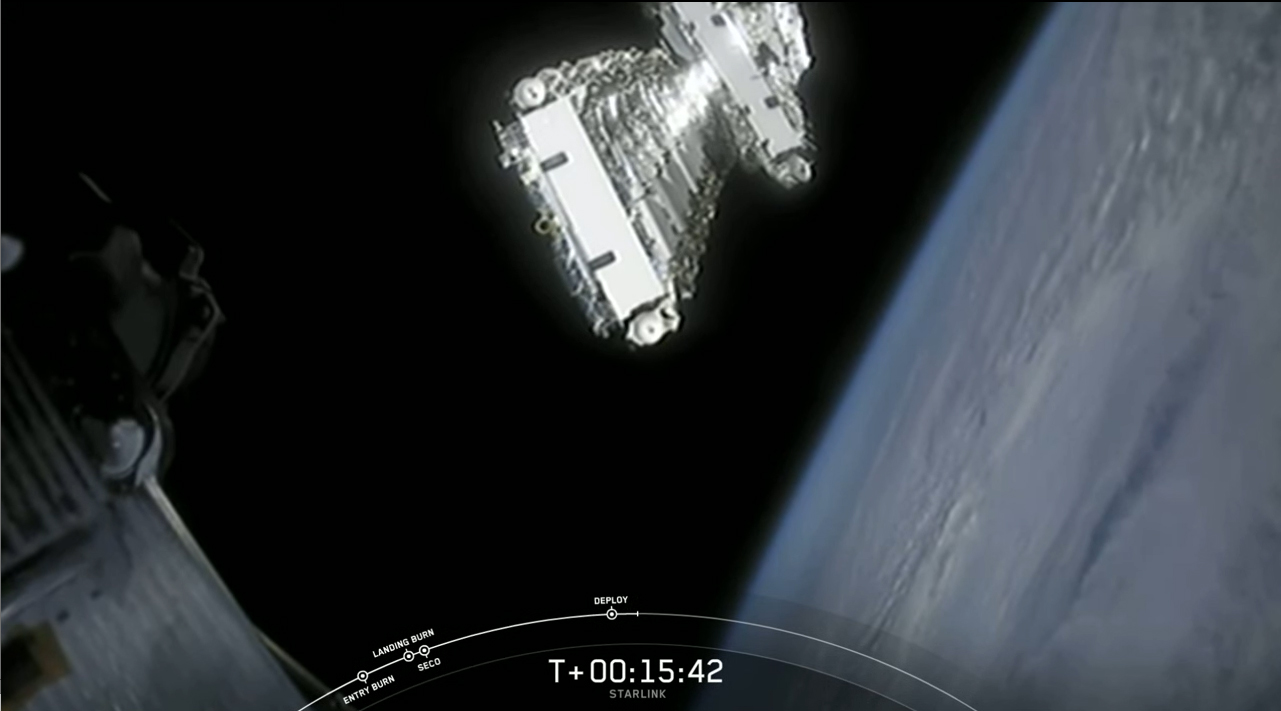SpaceX launches 60 Starlink satellites, aces rocket landing in milestone flight
The Falcon 9 has now flown 84 times, more than any other currently operational U.S. rocket.
CAPE CANAVERAL, Fla. — SpaceX successfully launched a new batch of 60 Starlink satellites into orbit today (April 22) and nailed a rocket landing at sea to cap the mission.
The extra-sooty Falcon 9 rocket — whose first stage had already flown three times before today's mission — lifted off at 3:30 p.m. EDT (1930 GMT) from Launch Pad 39A at NASA's Kennedy Space Center here, its white exterior marred by its previous trips through the atmosphere. The launch marked the 84th Falcon 9 flight, making SpaceX's workhorse rocket the most flown U.S. rocket in use today.
The rocket featured in today's flight joins the ranks of SpaceX's four-time fliers, having started its career by launching the Crew Dragon capsule on its first journey to the space station in 2019, an uncrewed flight called Demo-1. The booster then lofted a trio of Canadian Earth-observing satellites and the fourth Starlink mission earlier this year.
"We have a rocket," SpaceX engineer Lauren Lyons said during a webcast of today's launch. "This is the fourth landing for this booster."
Related: In photos: SpaceX launches third batch of 60 Starlink satellites to orbit



It was smooth sailing for SpaceX's Starlink satellites in today's launch, unlike the company's last flight. On that mission, one of the nine first-stage engines on the Falcon 9 shut down early. SpaceX engineers later determined that a small amount of isopropyl alcohol (a cleaning agent) was trapped in an area it could not flow through, causing the early engine shutdown.
Today's flight is the seventh operational Starlink mission, bringing the total number of satellites launched for the nascent broadband network up to 422. According to SpaceX founder and CEO Elon Musk, the company has plans to deorbit its two Starlink test satellites (Tin Tin A and Tin Tin B), which launched as part of a rideshare mission in 2018.
Breaking space news, the latest updates on rocket launches, skywatching events and more!
Musk has also said that at least 400 Starlink craft are needed before SpaceX can begin to roll out minimal internet coverage, and the company requires at least 800 satellites to provide moderate coverage. That service could start later this year.
The Starlink launch is one for the record books in a number of ways. First, today's flight marks the third time SpaceX has reflown recycled payload fairing pieces, which make up the "nose cone" that protects payloads during liftoff. Historically, the clam-shelled covering is a "one-and-done" component.
Once a rocket reaches a certain point in its ascent, the two pieces that make up SpaceX fairings are jettisoned and fall back to Earth. Typically, these pieces are discarded in the ocean, never to be used again. But for SpaceX, which has now successfully recovered more than 50 first-stage boosters, they’re the next step in the company’s quest to reuse more of the rocket.
SpaceX could save as much as $6 million per flight by reusing fairings, Musk has said. So, the company has outfitted its fairings with a navigation system to steer each half back to Earth and a parachute to help it gently land in either the ocean or in the outstretched nets of the company's recovery ships, GO Ms. Tree and GO Ms. Chief.
Of those vessels, only GO Ms. Tree (the boat formerly known as Mr. Steven) has successfully snagged falling fairings. SpaceX did not attempt fairing net snags today, because the company's boat and fairing software are being upgraded at the moment, company representatives said during today's launch webcast.
The fairing featured on today's flight was first used on the AMOS-17 mission last year. One half was caught by GO Ms. Tree and the other was scooped out of the ocean. Both were refurbished before encasing the stack of Starlinks.
Related: SpaceX's Starlink broadband service will begin in 2020: report
Today's flight also marked a significant milestone for the Falcon 9. The rocket now has 84 flights under its belt — more than any other currently operational U.S. booster. The superlative formerly belonged to United Launch Alliance’s Atlas V rocket, which has flown 83 times.
The Atlas V has two more launches on the books for this summer, one in May and one in June. The Falcon 9 has at least three on the books during that time frame, ensuring that SpaceX's workhorse will hang onto its new title for the foreseeable future.
Getting Starlink up and running involves more than launching satellites. The company also needs to gain approval for its user terminals — and that process is already well underway.
In March of this year, for example, SpaceX was granted approval for up to one million user terminals as part of a blanket license.
The hardware will be simple enough that anyone can install it, according to Musk, who has said the terminals look like a "UFO on a stick." The terminals will come with just two basic instructions — plug in and point at the sky — and are equipped with actuators that ensure they’re pointing where they should be at all times, Musk has said.
Following today’s successful liftoff, the veteran Falcon 9 booster, landed on a floating platform at sea, marking the company’s 51st successful recovery. The next flight on SpaceX's docket is another batch of Starlink satellites in May, followed by the company's first crewed mission, Demo-2.
On May 27, NASA astronauts Bob Behnken and Doug Hurley will climb aboard their Crew Dragon spacecraft and launch to the International Space Station for an extended stay. This flight will mark the first time humans have launched to orbit from U.S. soil since the end of NASA's space shuttle program in 2011.
- SpaceX's Starlink constellation could swell by 30,000 more satellites
- SpaceX's Starlink broadband service will begin in 2020: report
- 'Whoa, it worked': Elon Musk tweets via SpaceX's Starlink satellites
Follow Amy Thompson on Twitter @astrogingersnap. Follow us on Twitter @Spacedotcom or Facebook.
OFFER: Save 45% on 'All About Space' 'How it Works' and 'All About History'!
For a limited time, you can take out a digital subscription to any of our best-selling science magazines for just $2.38 per month, or 45% off the standard price for the first three months.
Join our Space Forums to keep talking space on the latest missions, night sky and more! And if you have a news tip, correction or comment, let us know at: community@space.com.

Amy Thompson is a Florida-based space and science journalist, who joined Space.com as a contributing writer in 2015. She's passionate about all things space and is a huge science and science-fiction geek. Star Wars is her favorite fandom, with that sassy little droid, R2D2 being her favorite. She studied science at the University of Florida, earning a degree in microbiology. Her work has also been published in Newsweek, VICE, Smithsonian, and many more. Now she chases rockets, writing about launches, commercial space, space station science, and everything in between.
-
richlite It is hard to get excited about this launch or any of the dozens upon dozens of Starlink launches when the skies become flooded with images like this one become the norm: https://spaceweathergallery.com/indiv_upload.php?upload_id=161494Reply -
Hari Starlink may be spoiling the view of the night sky for astronomers but it's the price of progress. If the people at SpaceX deliver on their promise of cheap, accessible broadband then the rest of us will not be as upset. Having also shown their Falcon 9 rocket to be the American equivalent of Russian Soyuz launchers, it is not "hard to get excited".Reply -
Postman1 I may be wrong about this, but if my memory serves me right, this may be the first time in US space launch history that a launch date was moved up. Every other change that I can remember, going back to Mercury: if the date was changed it was for a delay. Correct me if I'm wrong.Reply -
HumboldtRick More littering of space. Throwing all this garbage into orbit should be prohibited. This is criminal.Reply -
HumboldtRick ReplyHari said:Starlink may be spoiling the view of the night sky for astronomers but it's the price of progress. If the people at SpaceX deliver on their promise of cheap, accessible broadband then the rest of us will not be as upset. Having also shown their Falcon 9 rocket to be the American equivalent of Russian Soyuz launchers, it is not "hard to get excited".
So how is screwing up space progress???? You will NEVER see cheap broadband because GREED RULES and these companies will want to make every penny back and then some. The old "price of progress" BS is always spewed while corporations destroy nature. That is NOT progress. -
jfleetwd Reply
But how can you screw up space? It is already in a screwed up state. And what's wrong with having fast internet where it's never been and would never be without the satellites?HumboldtRick said:So how is screwing up space progress???? You will NEVER see cheap broadband because GREED RULES and these companies will want to make every penny back and then some. The old "price of progress" BS is always spewed while corporations destroy nature. That is NOT progress.
It can only be considered competion to the "greedy" land based ISP's and that never hurts. I have heard the suggested price will be around $80/mo. Even at that price it will be $30 dollars cheaper than my windstream connection. I say "Go Starlink GO!" -
COLGeek Just a couple thoughts.Reply
What goes up, will surely come down (some day).
More stuff in orbit means more opportunities for things to go wrong (like get out of position and damage other things).
Ground based astronomy is significantly impacted.
What happens when these companies or countries decide (for a variety of reasons) to give up on the these devices/efforts?
🤔🤔🤔🤔 -
Lovethrust Reply
Man that is depressing...richlite said:It is hard to get excited about this launch or any of the dozens upon dozens of Starlink launches when the skies become flooded with images like this one become the norm: https://spaceweathergallery.com/indiv_upload.php?upload_id=161494

